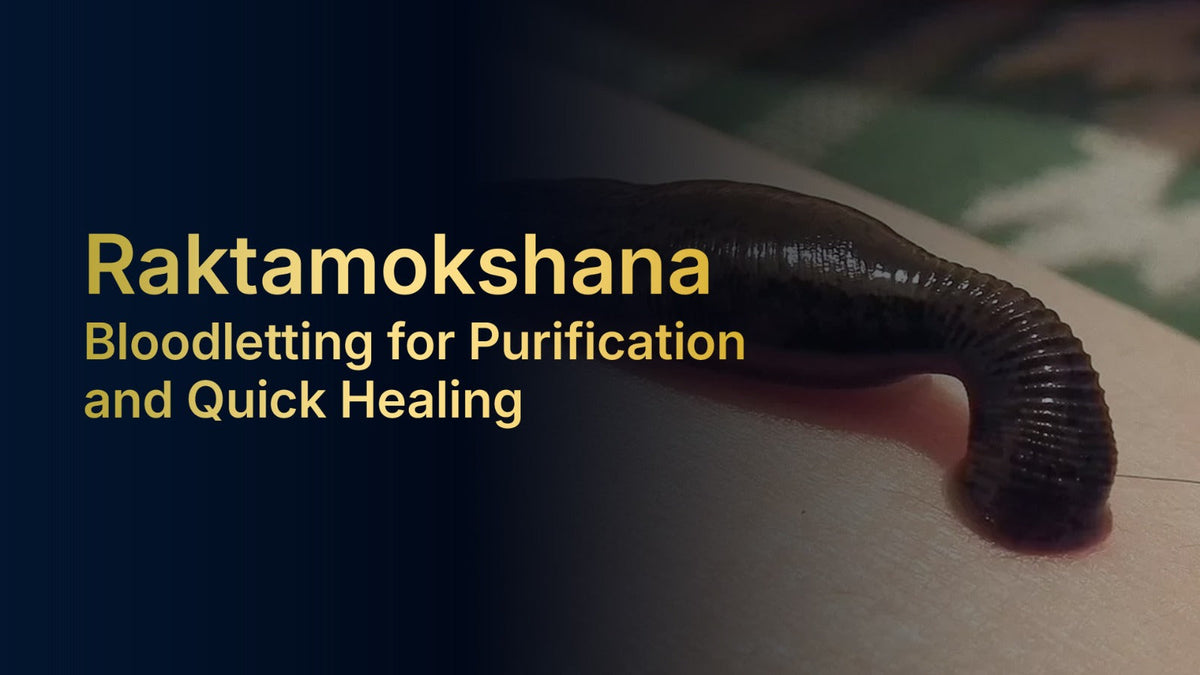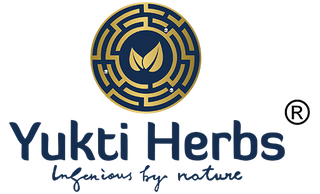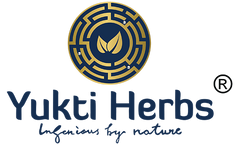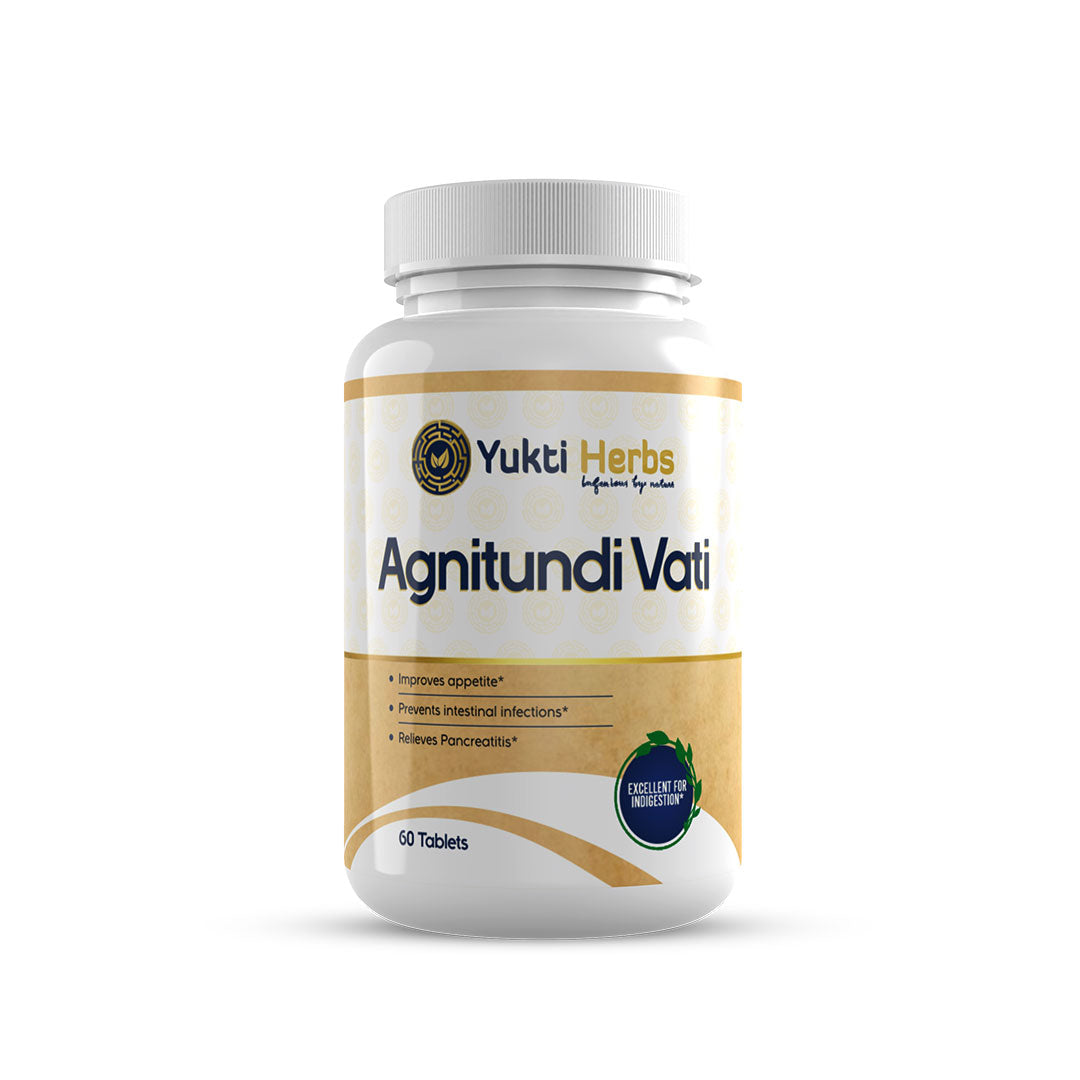
Raktamokshana: Bloodletting for Purification and Quick Healing
Detox, Heal, and Recover with the Instant & Effective Panchakarma Detox Therapy
Have you ever wondered why certain health issues persist and then won't go away despite modern medical solutions? What if an ancient Ayurvedic therapy existed that's been healing humanity for over 3,000 years? ‘Raktamokshana’, the sacred art of therapeutic bloodletting, could be the missing piece of your wellness puzzle. Not only does this profound Panchakarma Raktamokshana treatment relieve symptoms, but it also shines a light on the root cause by purifying your very life force – your blood.
This age-old treatment restores body balance by purging the body of vitiated or impure blood (दूषित रक्त➞ Dushita Rakta ‘impure blood’) — a potent detoxification process that reduces chronic conditions and helps the body rebalance itself from the inside out. Actually, Ayurveda itself regards the purity of blood as the key factor for life and vitality, as beautifully articulated in the classical shloka:
Shloka Reference
तद्विशुद्धं हि रुधिरं बलवर्णसुखायुषा | युनक्ति प्राणिनं प्राणः शोणितं ह्यनुवर्तते ||
Translation – When the blood is pure indeed, it supports the body, improves complexion, and attains joy and longevity; for in all living beings, the life force follows the state of the blood.1
At Yukti Herbs, we fuse classical Ayurvedic wisdom with clinical expertise to make Raktamokshana treatment safe, scientific and deeply healing for conditions including skin diseases, inflammation, varicose veins, and pain in the joints.
What is Raktamokshana? Understanding the Bloodletting Meaning According to Ayurveda
'Raktamokshana' is a Sanskrit term consisting of 'Rakta' and 'Mokshana', with 'Rakta' meaning blood and 'Mokshana' meaning to let free or to liberate. Therefore, the bloodletting meaning according to Ayurveda is the therapeutic technique of letting out vitiated blood as a way to remove toxins and restore internal balance.
The Secret Lifeblood: Why Vitiated Blood (Rakta) Is at the Root of So Many Modern Illnesses
According to Ayurvedic knowledge, blood (Rakta Dhatu) is one of the seven fundamental bodily tissues. When a person does not have optimal digestive fire (Agni), it will lead to the formation of Ama (toxins) in the body. Ama can then circulate in the blood and cause Raktadushti or vitiated blood. The impure blood is considered the root of many of the inflammatory and skin-based conditions. Raktamokshana is the ultimate treatment to resolve this issue and therefore is an important aspect of the Panchakarma protocols.
Vitiated blood can appear as:
-
Dermatitis such as psoriasis, eczema, acne, and urticaria
-
Chronic inflammation and other joint pathologies
-
Headaches and migraines of a particular kind
-
Varicose veins and other venous/circulatory issues
-
Wounds that do not heal through the typical process and abscesses
Bloodletting therapy's main purpose is to remove the pathology directly from the source of the condition, thus giving relief quickly, even when other therapies have not worked.

Two Major Categories of Raktmokshana: Surgical and Non-Surgical
The Ayurvedic texts provide an extensive explanation of the various techniques of Raktmokshana, grouped primarily by the method being performed.
1. Sastra Chikitsa (Surgical or Invasive Procedures)
These are procedures that require cutting the skin with sharp instruments to deliberately withdraw blood.
-
Pracchana – Several acute, shallow incisions to a specific area of the skin utilising a specialised instrument.
-
Siravedha – Allowing blood to flow from a specific vein (sira) using controlled and precise determination of how much apathogenic blood is allowed to flow. This is a specialised procedure that entails degrees of specialised training and knowledge.
2. Anushastra Chikitsa (Non-surgical / Minimal Invasive Methods)
This is where the famous ‘leech therapy’ treatment fits in, along with other brilliant methods.
-
Jalaukavacharana (Leech Therapy): It is the most well-known and often used method today.
-
Alabu (Gourd): Uses a vacuum effect by utilising its hollow horn or gourd to draw blood out of the body, like cupping.
-
Shrung (Horn): Same as Alabu, but instead of a gourd, it uses a cow horn.
Among these, Jalaukavacharana, or leech therapy in Ayurveda, rises to the top, for it is intelligent, more precise, and far less painful. It is currently the centrepiece of modern Raktamokshana treatment centres found in today's Panchakarma centres.
Shloka Reference:
“तत्र शस्त्रविस्रावणं द्विविधम् । प्रच्छानं सिराव्यधनं च ll”
Translation—Acharya Sushruta, known as the ‘Father of Surgery, describes two main surgical forms of ‘Raktamokshana’ or ‘bloodletting’ – Pracchana karma and Siravedha karma, Ayurveda’s holistic and safe purification therapies.2
Leech Therapy in Ayurveda: Nature's Intelligent Surgeon
The use of leeches, or Jalauka, showcases the observational brilliance of ancient Ayurvedic clinicians. The use of leeches in Ayurveda is not a blind, mediaeval practice but rather a sophisticated biological therapy.
Leech therapy, or “Jalaukavacharana”, is probably the best known and most unique type of raktamokshana treatment. Medicinal leeches (Hirudo medicinalis) have been utilised for thousands of years not only in Ayurveda but also in traditional European and Chinese medicine.
Leeches are procured from chemical-free freshwater, from which they are cleaned and prepared for clinical use. Only non-poisonous species are utilised, as well as with the highest standards of hygiene are maintained before, during, and after the application.
When the leech attaches, the leech painlessly pierces the skin and then draws a small, controlled amount of blood. But the real magic actually happens in the leech saliva. The saliva is rife with chemicals that consist of a potent cocktail of:
-
Natural analgesics (painkillers)
-
Anti-inflammatories
-
Platelet inhibitors
-
Anti-coagulants (hirudin)
-
Microcirculation enhancers
These chemicals not only prevent clotting during the process but also aid in recovery, minimising local swelling, and encourage healthy tissue regeneration.
The Healing Properties of Leech Saliva
|
Component |
Main Role |
Healing Benefit |
|
Hirudin |
Anticoagulant |
Keeps blood from clotting, increases blood circulation |
|
Calin |
Anti-inflammatory |
Reduces swelling and inflammation in damaged or infected tissues |
|
Destabilise |
Fibrinolytic enzyme |
Dissolves clots already in place and increases blood flow |
|
Natural anesthetics |
Pain relief |
Near painless treatment |
What is practically amazing about leech therapy in Ayurveda is that it is tolerable for sensitive people, children, elderly individuals, and those who are too weak to undergo another type of treatment. The objective of bloodletting in this way goes beyond the understanding of simply removing blood, it is a dirty biological process that stimulates healing at levels of the cells
Dosha, Bala, and Vishuddhi: The Ayurvedic Principles for Detoxification
According to Acharya Charaka, one must always do practitioner-guided bloodletting in relation to the strength of the individual (Bala) and the degree of Dosha-vitiation (Dosha-pramana) and the degree of Rudhira-vishuddhi is reached. The practising physician must also carefully assess the location of the disease (Ashaya).
Shloka Reference:
बलदोषप्रमाणाद्वा विशुद्ध्या रुधिरस्य वा। ;रुधिरं स्रावयेज्जन्तोराशयं प्रसमीक्ष्य वा॥
Translation: This verse exemplifies the value in assessing, dosing with precision, and "patient-centredness" in Raktamokshana Chikitsa, a representation of one of the guiding principles in Ayurveda – all detoxifications should be individualised while maximising the safety of the detox and the therapeutic benefit.3

The Three-Part Purification: The Method of Panchakarma Raktamokshana
The success of raktmokshana is solely dependent upon the precise technique and careful execution of the procedure. When you get your panchakarma raktamokshana at Yukti Herbs, the raktamokshana process is divided into three important phases, which will ensure safety and maximise therapeutic effectiveness.
1. Pūrva Karma (The Preparation Stage)
-
Mobilisation: The local area will often be prepared with a light oil massage (Snehana) and mild heating (Swedana). This will mobilise the deeply accumulated vitiated blood closer to the surface and improve the likelihood of success during the raktamokshana session.
-
Readiness Check: The physician must thoroughly assess your general state of digestion, strength, and degree of anxiety - before you can move forward with the actual raktamokshana treatment.
2. Pradhana Karma (The main cleansing phase)
-
Precision: The option that has been selected—the use of either Sira Vyadha or leeches—is implemented.
-
Targeted release: The volume of blood removed is precisely controlled and monitored. The historical goal of raktamokshana is not excessive blood loss but to modulate and remove that portion that is toxic.
-
Success indicator: The procedure ends only after the color of the blood that has been drawn goes from dark, thick, or frothy (impure) to neon or bright red (toxic). In a leech treatment in Ayurveda, the leeches indicate the procedure is over by falling off willingly.
3. Paśchāt Karma (The Healing Phase)
-
Sealing and Cleansing: The site of incision is dressed and sealed. After a leech treatment in Ayurveda, a simple turmeric paste is applied for its antiseptic and styptic properties.
-
Rakta-nourishment: This is essential. To deter Pitta from being re-aggravated and promote the body to produce new, healthy blood, the patient is given guidelines on dietary recommendations: light, cooling, and easily digestible. It is this post-treatment process that distinguishes the effect of the last bloodletting treatment as regenerative.
Post-Bloodletting Process According to Charaka Samhita
After bloodletting, foods and drinks taken should be light, easy to digest, and have a mild stimulating effect on the digestive fire (Agni). The Rakta (blood) and Agni (digestive fire) are both in a fragile and unstable state at this time, and therefore, the body should be supported and protected with the utmost attention.
Shloka Reference-
नात्युष्णशीतं लघु दीपनीयं रक्तेऽपनीते हितमन्नपानम्। तदा शरीरं ह्यनवस्थितासृगग्निर्विशेषेण च रक्षितव्यः॥
Translation- Acharya Charaka taught that the real efficacy of Raktamokshana goes beyond just bloodletting; it ultimately means that the body can restore its internal balance, redevelop digestion, and promote the healing power of the body.4
Challenging the Scepticism: Raktamokshana in Today’s Medical Practice
Bloodletting may sound odd to the uninitiated. And yet, modern medicine can be said to have learned raktamokshana:
-
Venesection for Haemochromatosis: The modern-day treatment for conditions involving an excess of blood cells (e.g., polycythemia vera) or iron is therapeutic phlebotomy—precisely what Sira Vedha is.
-
Microsurgery: Surgeons globally use leech therapy in Ayurveda (or just leeches) to relieve localized venous congestion or prevent tissue death in reattached limbs and skin grafts.
This demonstrates that the central principle of raktamokshana treatment—a targeted removal of bad blood—was not simply ancient wisdom but instead clinical relevance. When properly performed by a qualified Ayurvedic practitioner, the Panchakarma’s Raktamokshana approach is one of the safest and most effective deep cleansing therapies available today.
The key to implementing the true efficacy of raktamokshana is to understand the targeted blood letting definition-it is targeted medicine for the blood.
The Reason Ancient Texts Term Raktamokshana “Half Treatment” – A Classical Idea That Still Inspires
Acharya Sushruta included a whole chapter on leech therapy in the ancient healing system of Ayurveda in his well-known Sushruta Samhita. He called bloodletting "Ardhachikitsa" – or half treatment – which demonstrates the importance of raktamokshana as a therapeutic intervention.
But why did these ancient practitioners assign such significance to raktamokshana treatment?
The traditional texts teach us that blood has special significance with the Pitta dosha, one of the three primary forms of energy that governs your body. When Pitta is aggravated by too much heat, spicy foods, anger, or stress, it corrupts the blood in the body and can result in inflammatory diseases, skin diseases, and uneven metabolism.
Charaka said that panchakarma raktamokshana is therapeutic and preventive. If blood is regularly purified by bloodletting therapy, it can prevent many diseases and achieve balanced health throughout one's lifetime. These ancient observations are being corroborated by today's researchers, and it is becoming clear that our ancestors had a vast awareness of human physiology that we are just beginning to come to fully appreciate.
Advantages of Raktamokshana – More Than Just Detoxification
1. Clears the Skin, Enhances the Complexion
Raktamokshana facilitates the removal of impurities in the blood, and this can help to relieve skin conditions such as acne, psoriasis, and eczema. Patients often report having healthier skin with more of a glow after Raktamokshana has been performed
2. Reduces pain and inflammation
Leech therapy within Ayurveda is beneficial in releasing pain, inflammation, and stiffness by increasing blood circulation and draining toxic accumulation.
3. Increases mental clarity and reduces stress
Purified blood promotes oxygenation to your brain, which in turn increases focus, alertness, and emotional stability.
4. Boosts immunity and circulation
Bloodletting therapy strengthens the movement of bone marrow, encouraging it to produce new, healthy blood cells within your body – thus energising your system and strengthening your immunity.
5. Stabilises Pitta/Rakta
Excess heat (Ushna) and Pitta imbalance may often be the cause of inflammation or skin disorders. Raktamokshana treatment is an effective solution to help cool and calm the entire system.
Conditions Treated with ‘Raktamokshana Therapy’ at Yukti Herbs
Raktamokshana is not a single disease treatment. Its use is valuable in several chronic, lifestyle-based diseases.
Here are some conditions in which Raktamokshana treatment, or leech therapy in Ayurveda, is quite effective:
-
Skin Disorders: psoriasis, eczema, acne, pigmentation, abscesses
-
Joint Disorders: gout; arthritis; swelling; cervical spondylosis
-
Vascular disorders (veins): varicose veins; thrombosis; ischemic changes
-
Neurological Disorders: sciatica; migraines; facial palsy
-
Systemic or disease (vital signs): hypertension, liver disorders, poison or toxicity in the blood.
Overall, Raktamokshana works by purifying the Rakta as well as balancing the Doshas at the root source; hence, the long-lasting relief experienced by clients and no side effects.
Is Raktamokshana Suitable for You?
Understanding When Is Raktamokshana for You and Who Should Definitely Not Use It?
While the raktamokshana treatment is extremely safe in trained professionals' hands, there are certain conditions we would take note of.
Raktamokshana is contraindicated in individuals with:
-
Anaemia,
-
bleeding disorders,
-
severe fatigue or weakness,
-
pregnancy or active infection.
-
Individuals with food allergies to leech saliva, or
-
very low immunity,
These conditions require special care. Make sure to consult a professional to reduce risk. At Yukti Herbs, your safety is our number one concern, and we do extensive screening to maximise the success of your treatment.
Ideal candidates could be adults with chronic inflammatory disease or those interested in a holistic approach to chronic inflammatory diseases. Ideal candidates can also be indicated for muscle or joint pain, skin conditions, and preventive wellness care.
Shloka Reference:
अविस्राव्याः सर्वाङ्गशोफः क्षीणस्य चाम्लभोजननिम पाण्डुरोग्यर्शसोदरिशोषिगर्भिणीनां च श्वयथवः ॥
Translation: Bloodletting must not be done in people with generalised swelling; emaciated people who have consumed too much sour food; or anyone with anaemia, piles, gastrointestinal disorders, tuberculosis, who is pregnant, or has severe oedema.5

The Yukti Herbs Protocol: Your Safe Pathway To Raktamokshana
At Yukti Herbs, we approach Raktamokshana with both respect for tradition and an unwavering commitment to safety and hygiene.
Our Process:
Deep Consultation & Diagnosis (Nadi Pariksha)
Not everyone is a candidate for Raktamokshana. Our specialists will conduct a comprehensive pulse diagnosis and assessment to see if your Prakriti (constitution) and Vikriti (imbalance) are appropriate to your blood letting therapy.
Individualised Care Plan
We select the most suitable form—either leech treatment in Ayurveda or otherwise; the dosage, the site, and the timeframe.
Sterile & Certified Environment
The leeches used in our leech therapy in Ayurveda are medical grade, produced in sterilised laboratories, and are sterilised as they are only used once, preventing any cross-contamination.
Therapeutic Application
The leeches will be placed on the established sites. They drop off when they are full. When leeches bite, in most cases, the wound will heal with a small Y-shaped opening
After-Treatment Care & Rasayana
We clean the wound, place a sterile dressing on the bite, and provide you with instructions on dietary and lifestyle changes following the leech treatment. Most importantly, we also accompany you through the Rasayana (rejuvenation) programme of classical Ayurvedic herbs to encourage your body to produce new, healthy blood.
Safety Regulations We Implement
-
A thorough pre-treatment health evaluation
-
Meticulously chosen and prepped medicinal leeches
-
Adherence to hygiene and safety standards
-
Ongoing observation throughout treatment
-
Comprehensive aftercare and follow-up support for your treatment
Our knowledgeable physicians will tailor each leech therapy treatment based on your Ayurvedic constitution, state of health and therapeutic objectives to ensure effectiveness and completely safe treatment.
Your Next Step: Starting your Raktamokshana Healing Journey
Are you ready to explore the transformative healing arts of raktamokshana? A consultation to achieve your best level of health and energy is only a conversation away! Yukti Herbs is committed to guiding you through this ancient healing tradition with the care, skill, and total focus you deserve.
Don’t let chronic health conditions continue to rob you of your fullest potential in life. The ancient healing art of raktmokshana is waiting to, potentially, transform your health, and our experienced team of Yukti Herbs is here to guide you through it 100% of the way. This compassionate and ancient bloodletting treatment has already helped thousands of people return to their health naturally – could you be next?
Enter Into Wellness: Schedule Your Personalised Raktamokshana Consultation Today
Experience both ancient Ayurvedic bloodletting and leech therapy with the safety and hygiene offered by Yukti Herbs’ expertise, and work under the guidance of your trained leech therapy expert to create a personalised protocol that seeks to restore balance and healing in our modern world and see what others who have partnered with Yukti Herbs have experienced in true healing.
Book Consultation Explore IPD Program Visit Yukti Herbs
References:
-
Charak Samhita, Sutra Sthana, Chapter 24, Shloka 4
-
Sushrut Samhita, Sutra Sthana, Chapter 14, Shloka 25
-
Charak Samhita, Sutra Sthana, Chapter 24, Shloka 19
-
Charak Samhita, Sutra Sthana Chapter 24, Shloka 29
-
Sushrut Samhita, Sutra Sthana, Chapter 14, Shloka 24
Raktamokshana FAQ’s (Answering the Most Common Frequently Asked Questions)
No, in Ayurveda, leech therapy is not typically painful because the saliva of the leech has natural anaesthetic capabilities. Siravedha is also performed with great care to make you as comfortable as possible.
It really depends on the condition and how big the dosha imbalance is. Some conditions only need 1 or 2 treatment sessions, while chronic skin or joint conditions can see positive effects after 3-6 treatments for long-term results.
Raktamokshana means the controlled removal of impure blood to eliminate toxins and balance Pitta dosha, aiding in detoxification and healing.
Generally, yes, when done by experts. It’s avoided in pregnancy, anaemia, weakness, or active infections after careful evaluation.
You may experience a slight redness and/or some bleeding afterwards, which may be self-limiting and, in all likelihood, will resolve spontaneously. Overall, Raktamokshana is safe and effective when performed by a licensed and trained Ayurvedic doctor.












Leave a Comment